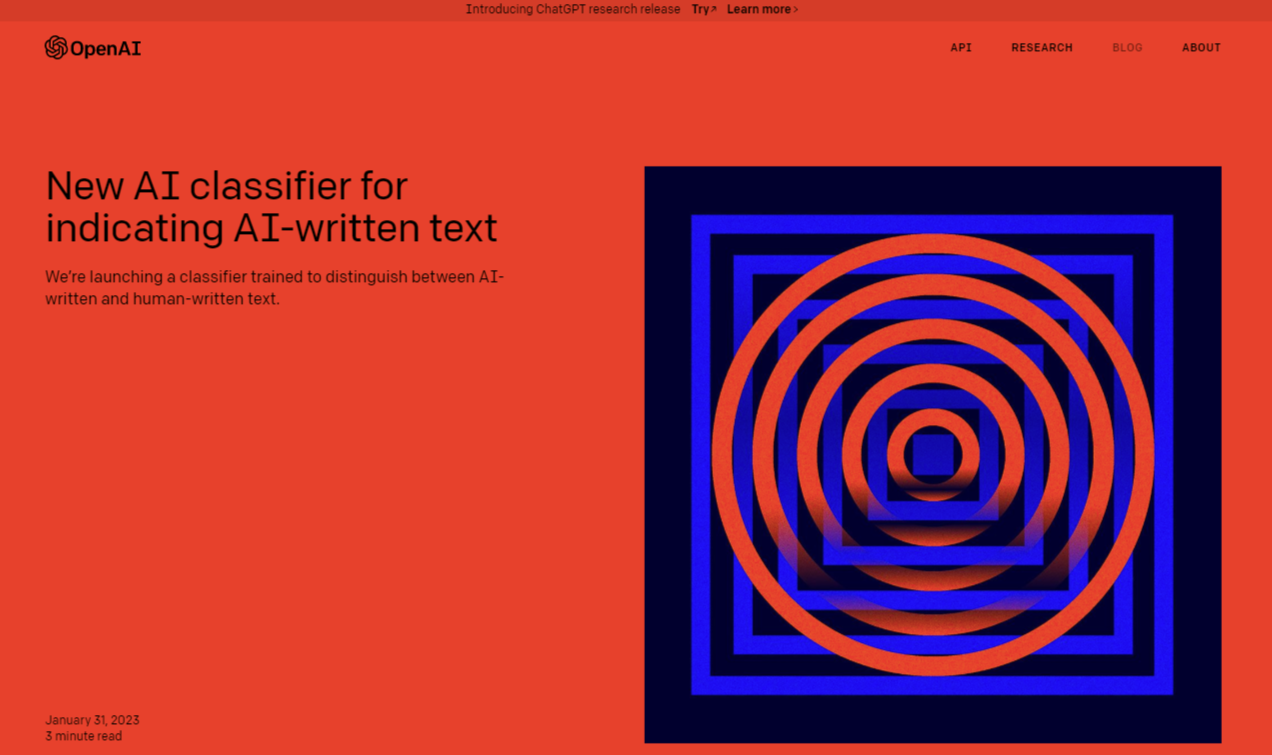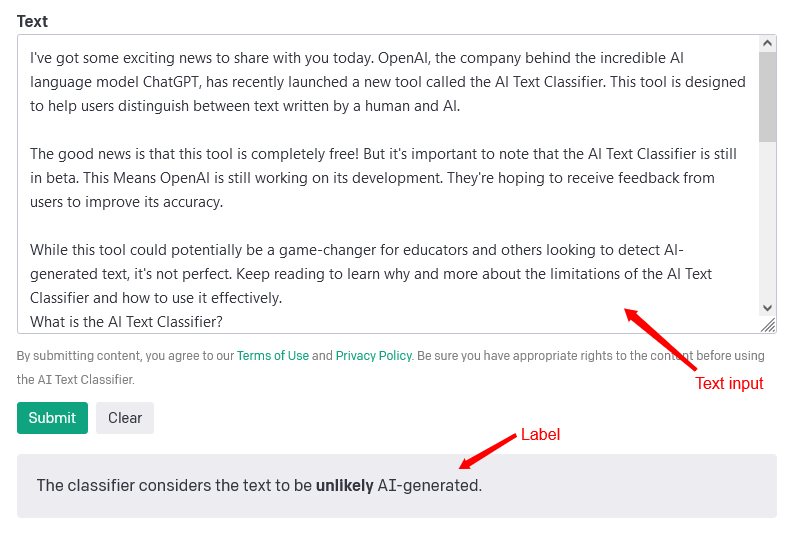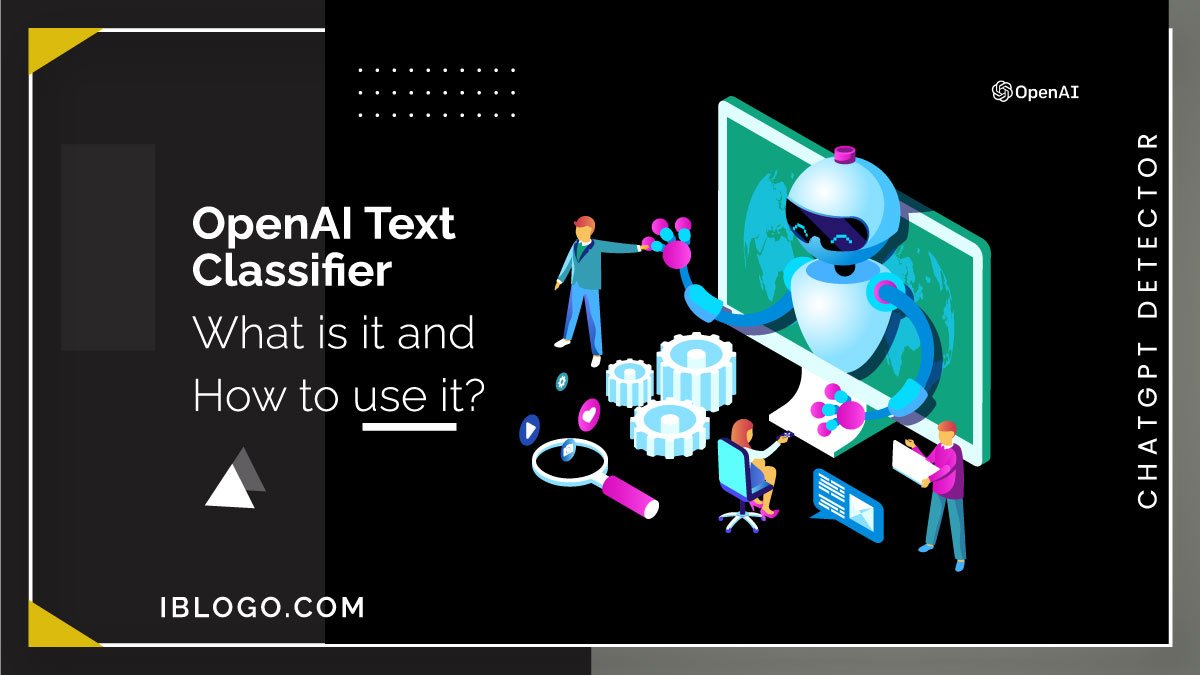OpenAI, the company behind the incredible AI language model ChatGPT, has recently launched a new tool called the AI Text Classifier. This tool is designed to help users distinguish between text written by a human and AI.
The good news is that this tool is completely free! But it’s important to note that the AI Text Classifier is still in beta. This Means OpenAI is still working on its development. They’re hoping to receive feedback from users to improve its accuracy.
This tool could be a game-changer for educators and others looking to detect AI-generated text. But it’s not perfect. Keep reading to learn why and more about the limitations of the AI Text Classifier and how to use it effectively.
[lwptoc hideItems=”1″]
What is the AI Text Classifier?

The AI Text Classifier is a tool created by OpenAI that can determine whether the text was written by a human or an AI. The tool uses a special GPT model to guess if AI created a text from different sources like ChatGPT.
The AI Text Classifier determines AI-generated text and prevents its use in contexts requiring human-generated content.
There’s also an important thing to keep in mind, which OpenAI notify:
“Our classifier is not fully reliable. In our evaluations on a “challenge set” of English texts, our classifier correctly identifies 26% of AI-written text (true positives) as “likely AI-written,” while incorrectly labeling human-written text as AI-written 9% of the time (false positives). Our classifier’s reliability typically improves as the length of the input text increases.”
If you want more accurate results from AI Text Classifier, you must input long-form content.
How to use the AI Text Classifier?
Using the AI Text Classifier is very easy. Users only need to input the text they want to analyze and wait a few seconds for the tool to provide a label. The AI Text Classifier provides five possible labels for the input text, very unlikely, unlikely, unclear if it is, possibly, or likely.
It is important to consider the following limitations before using an AI Text Classifier:
- You need at least 1,000 characters or around 150 to 250 words to use it
- The classifier is not always right and might wrongly label AI-generated and human-written text
- You can edit AI-generated text to avoid being caught by the classifier
- The text classifier might make mistakes when reading text written by kids or in languages other than English. This is because it was mainly taught to understand English content written by adults.
Let me show you a few examples of AI Text Classifier.

I Input text of 1767 characters (291 words) into AI Text Classifier that is generated through ChatGPT Plus. And it showed me “unlikely” to be AI-generated, which means a human writes the text.
Let’s try once more.

I Input text of 1872 characters (303 words), and AI Text Classifier showed me “likely” to be AI-generated, which means an AI tool generated the content.
I hope you’ve learned how to use Openai AI Text Classifier.
What are the AI Text Classifier Limitations?
OpenAI has provided a disclaimer regarding the effectiveness of the AI Text Classifier. The tool has been trained on a lot of text and tuned for specific datasets. But it’s not perfect and can give wrong results.
But here’s the good part. You can change the input text to avoid AI-generated detection. Also, using the tool with other methods of detecting AI-generated text is essential for accuracy.
OpenAI has outlined some current limitations to the classifier, including the fact that it’s not fully reliable and shouldn’t be used as a primary decision-making tool.d
Here are some points to keep in mind:
- The classifier can be very unreliable when it comes to short texts (under 1,000 characters). Even longer texts can sometimes be incorrectly labeled.
- Interestingly, the classifier may also mistakenly identify the human-written text as AI-generated and do so confidently.
- It’s worth noting that the classifier is most effective for English text. It performs quite worse with other languages and is unreliable for code.
- Highly predictable text is not a reliable indicator of whether a human or AI wrote it. For example, you were given a list of the first 1,000 prime numbers. It would be impossible to tell if a person or an AI wrote it because the answer would always be the same.
- It’s also possible to edit AI-generated text in a way that makes it more difficult for the classifier to detect.
- Lastly, classifiers based on neural networks can be poorly calibrated outside of their training data. Sometimes, the classifier may be extremely confident in a wrong prediction when it encounters inputs that are very different from the text in its training set.
OpenAI Text Classifier Features: Intuitive Interface, Fast Results, and More
The key features of an AI text classifier, or an AI detection tool, include:
Training on large datasets:
AI text classifiers are trained on large datasets of text, often using supervised learning techniques, to recognize patterns and classify new text inputs accurately.
Intuitive user interface:
Modern AI text classifiers typically have an intuitive user interface that makes them easy to use, even for non-experts.
Fast and accurate results:
AI text classifiers are designed to deliver fast and accurate results, allowing users to quickly analyze large volumes of text and make informed decisions.
Free at the moment:
OpenAI’s Text Classifiers are available for free. which makes them accessible to a broad audience.
What are the Pros and Cons of the OpenAI Text Classifier tool?
Pros
- An easy-to-use interface
- The tool is designed to provide quick results to users. It saves time and enables users to make decisions rapidly.
- OpenAI Text Classifier provides free access to unlimited scanning of text documents.
- Can detect ChatGPT, jasper, or closerscopy written content.
Cons
- According to OpenAI’s own tests, the Text Classifier only has a 26% success rate in distinguishing AI-generated text from human-written text, which limits its effectiveness.
- The tool currently lacks a plagiarism feature.
- Not Reliable for Non-English Texts
- Limited features
Why do you need the AI Text Classifier?
The importance of detecting AI-generated text cannot be overstated. Google’s guidelines on automatically generated content explicitly restrict using AI-generated text.
And websites that violate these guidelines may face penalties, which could harm their website and ranking. The AI Text Classifier is a tool that can identify AI-generated text and tells you to use human-generated content.
Conclusion
OpenAI’s new tool, the AI Text Classifier, is a valuable resource for detecting AI-generated text in various contexts. The tool is still in beta and not always accurate. But its ability to distinguish between human and AI-generated text could be a game-changer for educators and content creators.
The tool has some limits to keep in mind. It works better for longer content. Short texts might not get reliable results. Also, it might not work well for non-English text.
Overall, the AI Text Classifier is a helpful preventive measure to ensure that websites maintain their reputation for high-quality, human-written content and avoid penalties for using AI-generated text.
This was my article about AI Text Classifier. I hope you find this helpful.
Some FAQs
Can I use OpenAI for free?
You can kickstart your experiment with a free credit of $18 that can be utilized within the first three months.
What is text classification in AI?
Text classification is an advanced method in machine learning that assigns predefined categories to open-ended text. The use of text classifiers is not limited to specific types of text. And it can be employed in categorizing and organizing various kinds of textual data, including documents, medical studies, files, and online content. This technique enables the structuring and grouping of textual information. It enhances the efficiency of categorizing and analyzing large amounts of data.
Can AI detect AI text?
Detecting AI-generated text is a challenging task, as it can often simulate human writing styles and patterns. However, with the help of advanced machine learning algorithms, it is possible to develop reliable classifiers that can accurately identify such text.
Does OpenAI Text Classifier detect plagiarism?
OpenAI Text Classifier currently lacks a plagiarism feature, which means users cannot detect whether a given text is a copy of another text or not.
Is OpenAI Text Classifier reliable for non-English texts?
OpenAI Text Classifier is mainly trained on English texts, and its effectiveness may be limited when analyzing texts in other languages.

